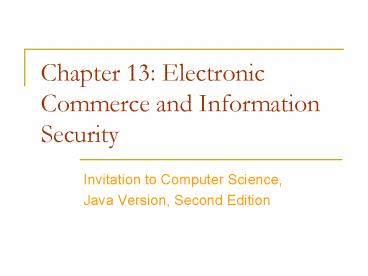Chapter 13: Electronic Commerce and Information Security - PowerPoint PPT Presentation
1 / 24
Title:
Chapter 13: Electronic Commerce and Information Security
Description:
... store requires at least as much planning as building another physical store location ... Manage and store customer information ... – PowerPoint PPT presentation
Number of Views:71
Avg rating:3.0/5.0
Title: Chapter 13: Electronic Commerce and Information Security
1
Chapter 13 Electronic Commerce and Information
Security
- Invitation to Computer Science,
- Java Version, Second Edition
2
Introduction
- E-commerce financial transactions conducted by
electronic means - Early days (early and mid-1990s) of online
commerce - A customer fills out an order via the Web and
submits it - The online order is printed out by the business,
and then processed like a traditional purchase
3
Introduction (continued)
- E-business
- Every part of a financial transaction is handled
electronically, including - Processing of orders
- Verification of credit
- Completion of transactions
- Issuing debits
- Alerting shipping
- Reducing inventory
4
E-commerce
- Opening an online store requires at least as much
planning as building another physical store
location
5
The Vision Thing
- In planning for opening an online store, a
company must access - Its objectives
- Risks involved
- Costs involved
- The company should go ahead with its plans only
if it is determined that its overall bottom line
will improve by going online
6
Decisions, Decisions
- Personnel
- In-house development or outsourcing
- Hardware
- Web server machine
- Additional computers
7
Decisions, Decisions (continued)
- Software programs to
- Process customer orders
- Interact with accounting, shipping, and inventory
control software - Manage and store customer information
8
Anatomy of a Transaction
- Goals for an online business
- Draw potential customers to your site
- Keep them there
- Set up optimum conditions for them to complete a
purchase - A typical online transaction can be divided into
nine steps
9
Step 1 Getting There
- How can you get customers to your Web site?
- Conventional advertising
- Obvious domain name
- Search engine
- Portal
10
Step 2 Do I Know You?
- Providing Web site personalization by
- Asking the user to register and then log-in on
each visit - Using cookies
- Providing incentives and benefits for return
customers
11
Step 3 Committing to an Online Purchase
- Must provide security for transmitting sensitive
information - Encryption encoding data to be transmitted into
a scrambled form using a scheme agreed upon
between the sender and the receiver - Authentication verifying the identify of the
receiver of your message
12
Steps 4 and 5 Payment Processing
- Most common payment option credit card
- Option 1
- Step 4 Online order form communicates with the
accounting system - Step 5 Accounting system verifies the customers
credit and process the transaction on the fly
13
Steps 4 and 5 Payment Processing (continued)
- Option 2
- Step 4 Collect information on the customers
order - Step 5 Evaluate the customers credit and
complete the transaction offline
14
Steps 69 Order Fulfillment
- Step 6 Order entry system alerts inventory
system to reduce the items in stock - Step 7 Order entry system contacts shipping
system to arrange for shipping - Steps 8 and 9 Shipping system works with the
shipping company to pick up and deliver the
purchase to the customer
15
- Figure 13.1 A Typical Online Transaction in Nine
Steps
16
Databases
- An electronic database
- Stores data items
- Data items can be extracted
- Data items can be sorted
- Data items can be manipulated to reveal new
information
17
Data Organization
- Byte
- A group of eight bits
- Can store the binary representation of a single
character or of a small integer number - A single unit of addressable memory
- Field
- A group of bytes used to represent a string of
characters
18
Data Organization (continued)
- Record
- A collection of related fields
- Data file
- Related records are kept in a data file
- Database
- Related files make up a database
19
Database Management Systems
- Database management system (DBMS)
- Manages the files in a database
- Relational database model
- Conceptual model of a file as a two-dimensional
table
20
Database Management Systems (continued)
- In a relational database
- A table represents information about an entity
- A row contains data about one instance of an
entity - A row is called a tuple
- Each category of information is called an
attribute
21
Database Management Systems (continued)
- Specialized query languages
- Enable the user or another application program to
query the database - Example SQL (Structured Query Language)
- Relationships among different entities in a
database - Established through the correspondence between
primary keys and foreign keys
22
Other Considerations
- Performance issues
- Large files are maintained on disk
- Organizing record storage on disk can minimize
time to access a particular record - Creating additional records to be stored with the
file can significantly reduce access time
23
Other Considerations (continued)
- Distributed databases
- Allow physical data to reside at separate and
independent locations that are networked - Massive, integrated government databases raise
legal, political, social, and ethical issues
24
Key Terms































